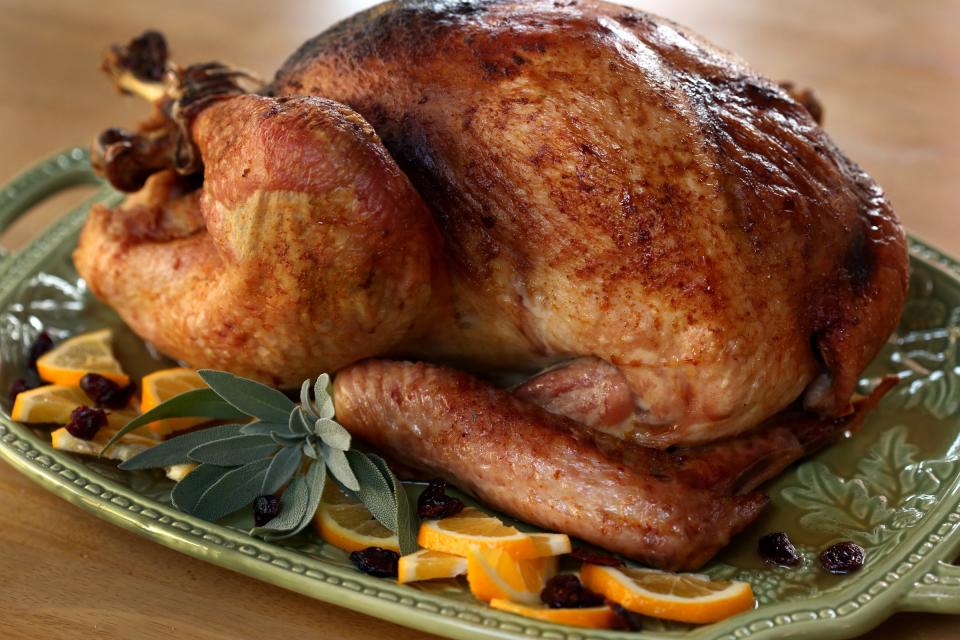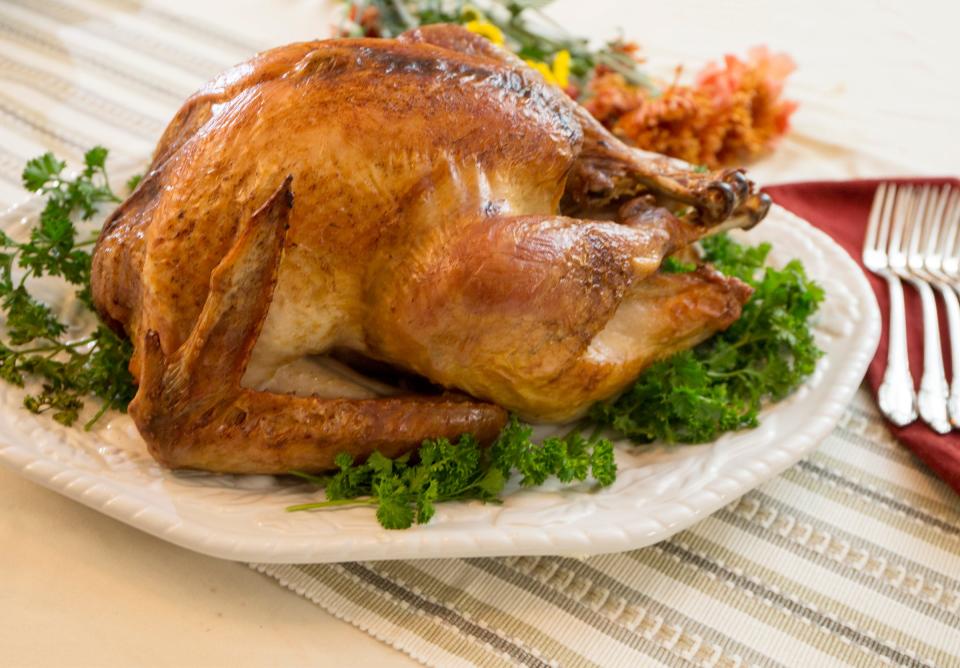Here's why, how to brine your Thanksgiving turkey
Most of the turkeys that were roasted in the former Free Press Test Kitchen were brined in some fashion. The practice of brining your Thanksgiving turkey became super popular a few decades ago. Brining was a way that would nearly guarantee a moist and flavorful Thanksgiving turkey. And come Thanksgiving, everyone wants to get it right.
The end goal is always the same: Turkey with flawless, crisp, golden deep honey-colored skin with tender juicy meat.
Brining a turkey using the wet or dry method — though the dry is favorable — is still a good practice to achieve that goal.
So why brine? Because cooking a whole turkey is challenging.

Years ago, the recommended levels of doneness for turkey involved one internal temperature for the breast and another, higher temperature for the thighs and legs. Achieving that is quite a challenge. Now, U.S. Department of Agriculture (USDA) deems an internal temperature of 165 degrees for the whole turkey is just fine.
In a nutshell, wet brining adds seasoned moisture to the bird. Once you've brined, the turkey needs to be rinsed well to avoid salty pan drippings. The skin is another issue. After rinsing the turkey, you need to let it rest uncovered in the refrigerator so the skin dries out.
If you don't want to wrestle with a big bucket of water, you can dry brine the turkey. It works just as well, drawing seasoning into the turkey and seasoning it throughout.
More: Thanksgiving dinner will be less expensive this year — but still 25% higher than 2019
Note: You should not brine self-basting or kosher turkeys.
Here are instructions to wet or dry brine a 12-15 pound turkey.
More: Food prices remain stubbornly high despite inflation showing signs of easing
Dry brine
Ingredients: 4 tablespoons kosher salt (or a mix of salt, brown sugar or herbs.)
Equipment: Oven bag or sealable bag to hold the turkey. Baking sheet or sided dish.
How-to: At least one day before roasting, rinse the turkey and pat dry. Sprinkle 1 tablespoon of kosher salt in the turkey cavity. Rub the remaining salt all over the bird. Place the turkey in the bag and refrigerate for 12 hours. There should be no visible salt on the skin. Let stand at room temperature for 1 hour before roasting.
Wet brine
Ingredients: 2 cups of kosher salt (or mix of 1 cup salt and 1 cup sugar), 2 gallons of water. You can also use other liquids such as wine, juices, cider and beer.
Equipment: Tall 5-gallon bucket and room in the refrigerator for the bucket.
How-to: Place 4 cups of the water in a saucepan and add the salt. Heat over medium heat until the salt is dissolved. Remove from heat and add ice cubes to cool. Place the mixture with the remaining water in a bucket.
Submerge the turkey, breast side down.
Place the bucket in the refrigerator at least 12 hours and up to 24 hours. Before cooking, remove the turkey and discard the brine. Rinse under cold water, pat dry and return to the refrigerator for another couple of hours to dry the skin. Let the turkey sit one hour before roasting.

Dry-Brine Turkey with Herb Butter Baste
Serves: 10 / Prep time: 20 minutes (plus brining time) / Total time: about 3 hours
The original recipes call for 3 tablespoons of brown sugar. Feel free to use it if you like. Because all of the brine doesn't adhere, it adds a minimal amount of carbohydrates.
1/2 cup kosher salt
1 1/2 teaspoons dried thyme
1 turkey about 12- to 14-pounds, neck and giblets removed, patted dry
2 sprigs rosemary
2 garlic cloves, crushed
1/2 cup (1 stick) unsalted butter
1 tablespoon reduced-sodium tamari (gluten-free soy sauce)
Mix together the salt and dried thyme. Place the turkey on a flat or V-shaped roasting rack set on a sided baking sheet or inside a large roasting pan. Sprinkle the salt mixture all over the turkey, inside and out, making sure to salt the areas around the neck, top of breast and between the legs and breast. Place in the refrigerator, uncovered, at least 12 hours and up to 2 days.
Rinse turkey and pat dry. Rinse roasting pan and rack if needed. Pat the turkey dry; let sit 30 minutes. Place oven rack in lower third of oven; preheat the oven to 425 degrees. Place turkey, breast side up, on rack in roasting pan and pour 1 cup water into pan. This will prevent drippings from burning. Roast turkey, rotating pan back to front halfway through and adding more water by 1/2-cupfuls as needed to maintain some liquid in the pan, until skin is browned all over, 35–45 minutes.
Meanwhile, cook rosemary, garlic, butter, and soy sauce in a small saucepan over medium heat until bubbling and fragrant, about 5 minutes; keep warm.
Reduce oven temperature to 350 degrees and continue to roast turkey, basting with butter mixture every 10–15 minutes and rotating pan every 30 minutes or so if bird is browning unevenly, until an instant-read thermometer inserted into the thickest part of breast registers 150 degrees, about 40-70 minutes. Upon resting, the temperature will continue to increase. Transfer turkey to a cutting board and let rest at least 30 minutes and up to 1 hour before carving.
If desired, heat the pan over high heat, adding chicken or turkey broth, and scrapping up any browned bits. Strain the pan juices into a bowl and skim off the fat. Whisk in some cold butter and pour pan juices over turkey.
Adapted from bonappetit.com.
Tested by Susan Selasky for the Free Press Test Kitchen.
Contact Detroit Free Press food and restaurant writer Susan Selasky and send food and restaurant news and tips to: sselasky@freepress.com. Follow @SusanMariecooks on Twitter. Subscribe to the Free Press.
This article originally appeared on Detroit Free Press: Brining your Thanksgiving turkey: Tips and techniques to know

